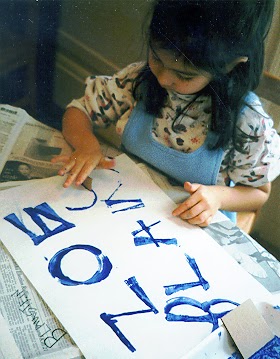Begin a letter exploration by focusing on the straight-edge capital letters since only one tool – the large, straight cardboard line tool – is needed. Personalize the experience by choosing a straight-edge letter from a child’s name and asking, “Do you think you could figure out how to print a _______ with this line stamp?”
Allow time for children to practice creating letters with the straight line tool (no paint)
If possible, suggest that children begin with the letters that are easiest to construct – those made from horizontal and vertical lines. Letters with diagonal lines are trickier to construct.
Introduce the Curved Line Tool
The best time to add a curved line tool is when you observe that children have a need for it. When I held up the curved line tool I heard a chorus of children saying, “Now I can make my P… D… S… J…” They knew they needed a curve!
Take time to brainstorm and play with strategies for constructing letters that are particularly difficult to print such as B, D, G, J, Q, R, S.
Cut the inside of masking tape rolls, or cut paper coffee cups in half and trim to make the large curved line tool.














